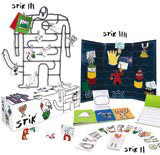Inclusive thinkers take up the Design Challenge

Five consultancies have been shortlisted for the Design Business Association’s Design Challenge award, an annual competition to promote innovation through inclusive design.
Corporate Edge has created a communication toolkit for dyslexics, while Pearson Matthews offers an easy-to-apply surgical plaster. Also on the shortlist are Enterprise IG’s ‘Kite mark’ brand OOP, which shows that inclusive products and services conform to an agreed standard; Lacock Gullam’s design to improve bus shelters and Rodd Industrial Design’s overhaul of the domestic vacuum cleaner to cater for users of all abilities.
Now in its fifth year, the competition is a collaboration between the DBA and the Helen Hamlyn Research Centre at the Royal College of Art. It promotes the design of products and services that meet the widest range of user needs.
Lacock Gullam’s bus shelter looks to provide all passengers with an accessible experience. A smart-card system similar to Transport for London’s Oyster cards would enable disabled users to access information tailored to their needs – a visually impaired user could activate an audio message when the card is swiped, for example.
At the same time, the cards would alert the driver of an approaching bus that a user with special needs is waiting.
‘The design is a combination of existing technologies with some physical changes to the shelters,’ says Lacock Gullam product designer Georges Zigrand. ‘Most developments in shelter design we have seen are for the operators, not for the users,’ he adds.
Pearson Matthews’ Clevername plasters are created for easier application than a standard plaster. ‘I realised how much difficulty I was having applying a plaster after cutting my finger,’ says lead designer Stuart May. ‘We thought that disabled people may have even more difficulty.’
The T-shaped plasters are presented as tabs in a cardboard pouch. Pulling the tab reveals an adhesive section, which is placed over the wound, then the remainder of the plaster can be applied.
The backdrop to the Design Challenge’s objectives is a population of 6.8m disabled people of working age in the UK and more than 50m people with some degree of disability across the European Union. The commercial case for inclusive design is bolstered by the spending power of this group: £80bn per year across Europe, according to estimates by HHRC.
Creative industries are also home to a disproportionate number of dyslexia sufferers. Corporate Edge’s Stik is a four-part toolkit to help dyslexics ‘communicate, take briefs and arrive at solutions’. The judges felt that Stik ‘truly expressed the spirit’ of the challenge.
Professor Jeremy Myerson, co-director of the HHRC, believes that the scheme has developed significantly since 2000. ‘When we started the programme it was a bit of a shock to many designers what the needs of disabled users are,’ says Myerson. ‘Five years down the line there is a heightened awareness of inclusive design. The whole design industry is more attuned to and savvy about disabled users and the role they can play in product development.’
Myerson says that taking part in the challenge can broaden the range of clients that consultancies are able to approach. ‘It gives them a portfolio [of inclusive design work] to take to new clients. The whole programme is about knowledge transfer.’
The winner of the DBA Design Challenge will be announced at an awards ceremony at the RCA in London on 23 February.
-
Post a comment




